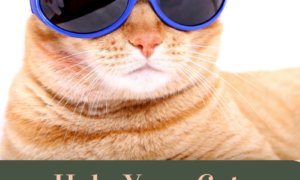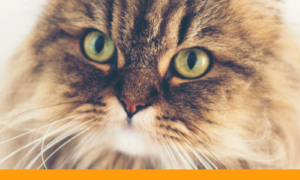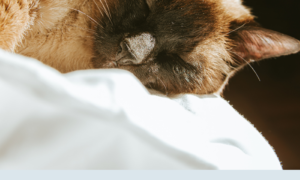By Darcy Lockman for The Daily Cat

Last January, Ingrid Duthie’s favorite pants became very uncomfortable. Holiday parties led to extra calories, along with less time at the gym, for the 40-year-old Detroit native. She wasn’t surprised she’d put on a few additional pounds, but she was taken aback when she noticed some extra girth on her 6-year-old cat, Felix, too. “I was probably more aware of Felix’s belly since I was thinking a lot about my own, but I’d always thought of him as skinny, since he was very thin as a kitten,” she remembers.
At Felix’s annual checkup the following month, his veterinarian confirmed that Duthie’s small-boned feline had added two pounds in the last year — increasing his weight by more than 20 percent. He prescribed the following treatment: fewer calories, more calorie-burning. Below, veterinarian Trisha Joyce, DVM, of New York City Veterinary Specialists, weighs in on how cats acquire tubby tummies and how you can help to reverse the damage.
Why Cats Get Fat
According to Dr. Joyce, feline obesity has reached epidemic proportions in the U.S. This is accompanied by health problems all too familiar to Americans: diabetes, arthritis and even premature death. But unlike dogs and humans, underlying health issues usually do not cause feline obesity, according to Dr. Joyce. “In dogs we’ll see hypothyroidism, but it almost never happens in cats,” she says, explaining that this condition slows down an individual’s metabolism. Hyperthyroidism, which causes just the opposite to occur, is far more common among felines.
So what does cause feline obesity? Lifestyle. “Overweight cats are that way because of overfeeding and lack of exercise,” she says. “Some cats are good at regulating their food intake, but others are not. If too much food is made available to them, they will eat it.” Indoor cats generally don’t have much stimulation in their environment — they aren’t stalking, chasing, jumping. Indoor cats are safe from trauma, which is obviously critical to their well-being, but they also sit a lot.
How Cats Get Thin
“Weight loss diets have the most successful outcomes,” says Dr. Joyce. This includes both a commercial weight loss formula and portion control. “I recommend wet food, but only because it seems easier for owners to regulate how much they are feeding. Also, it’s eaten in one shot, so if there are two cats in the household, there is less chance for the fatter cat to eat the skinnier cat’s portion.” Dr. Joyce also recommends strictly limiting treats and eliminating table scraps altogether. A food containing the amino acid L-carnitine may also be beneficial, as it helps to burn fat while maintaining lean muscle mass.
Though a gym membership may not be in your kitty’s future, exercise should be on the menu. But be prepared. Getting Fluffy moving may take a dedicated and creative owner. “See what your cat responds to,” Dr. Joyce says. “Some enjoy chasing a laser light, which you can operate from the couch. You can put a cat on a harness and an extendable leash and let it run around an enclosed yard with you. Make your cat work for its food — take the bowl and ask it to follow you around the house to get it.” If adopting a kitten is an option, a younger companion’s eagerness to play and chase may also get your adult cat off the couch.
Enlisting Professional Help
Unlike dogs and humans, cats cannot tolerate severe calorie restriction. Consult your veterinarian about acceptable portion sizes for weight loss in order to avoid fatty liver syndrome, a serious condition affecting the liver that results when cats do not consume enough calories. Adds Dr. Joyce, “Fatty liver syndrome is also something to be aware of if you introduce a new cat into the home. The first cat may go on a hunger strike, to act out, which can seriously endanger its liver functioning.” She suggests monitoring the first cat’s food intake closely while the felines become acquainted.
Darcy Lockman is a Brooklyn, N.Y.-based freelance writer and frequent contributor to The Daily Cat. Her work has appeared in publications such as the New York Times and Rolling Stone.





